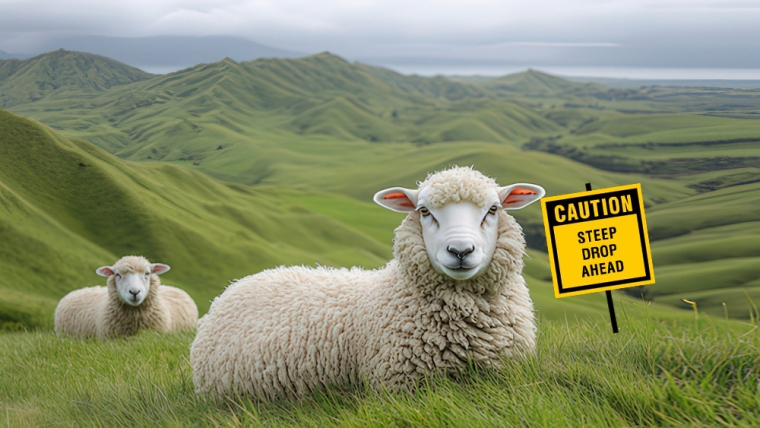
This year is a remarkable time for sheep and beef farms, with record prices for both lamb meat and beef. Farm-gate prices are up in the order of 30% since 2024 and in some situations even more. It is a sweet spot that won’t be maintained.
I know of no-one who foretold the current sweet spot. It remains somewhat of a puzzle to understand and put the causes in some sort of order.
One but only one of the causes is the decline in the New Zealand dollar. Currency rates are volatile and trends depend very much on the starting point. By my reckoning, the New Zealand dollar has dropped on average around 5% over the last year relative to the US dollar.
Depreciation against the euro has been about 9% over this time.
The Chinese yuan has jumped around over the last year relative to the New Zealand dollar, but over a two-year period the trend is that the New Zealand dollar is down about 5%.
These are the three most important currencies for our red meat industries. By my reckoning, the combined effect at farm gate on sheep and beef meat prices has been between 5% and 10% higher returns.
That leaves a lot to be explained.
In the case of beef, a lot of the upsurge in farm-gate prices relates to the US beef cycle. This cycle has been around for some 50 years or more. I have been watching it for all of that time. Each cycle typically takes eight to 10 years.
When beef prices are on an upswing in America, then American graziers retain their heifer cows and less female stock goes to market. This pushes beef prices even higher.
Eventually the market reacts to the high prices and consumer demand declines. This causes prices to drop.
Graziers then decrease their herd sizes, which puts more beef onto the market. This accentuates the decline in beef prices.
Right now, American beef production is at a low point and so prices are high. In response, graziers are keeping back all their female young stock for breeding. This means even less American beef is coming to market than would otherwise be the case.
It will be several years before the beef from the progeny of the retained heifers reaches the market.
All of this means American beef prices should, other things being equal, stay high for several years.
This is good news for New Zealand given that the USA is New Zealand’s most important beef market. This New Zealand beef is typically mixed into hamburger beef with American beef, to reduce the overall fat content and to give an overall cheaper mix.
Of course, all other things are not equal, and that includes Donald Trump’s 15% tariff on all products sourced from New Zealand. But so far, it seems that most of this tariff is getting paid by the importers, without much of it being transferred back to the New Zealand price. That may change as the main New Zealand slaughter period comes into play.
In the case of lamb there is no equivalent lamb cycle to the beef cycle. This is largely because of the shorter biological cycle of sheep compared to beef.
However, there has been a recent decline in European sheep-meat production linked to environmental regulations. Only time will tell how that plays out.
Whereas European markets are not important for New Zealand beef, they are very important for lamb.
My own judgement is that sheep-meat prices are not sustainable even in the short term. For example, the chief purchase officer in my family tells me that, despite lamb being my favourite meat, she is purposely buying less lamb because of cost.
Accordingly, my judgement is that the price of lamb back to farmers will drop significantly as soon as the main killing season starts in a matter of a few weeks. In fact, it always does drop come December. But this year it would not surprise me if it drops even more than the normal seasonal decline.
This means that farmers need to be cautious and wait until they see the cash in their hands before they make big spending decisions.
The other unknown is how the meat processing companies will operate this year.
What we know for sure is that these companies have spare processing capacity. We also know that using that capacity is fundamental to generating a profit.
In addition, we know that competition for livestock has contributed in a big way to company losses in recent years, particularly in relation to lamb.
The meat processing industry is notoriously challenging, particularly for lamb and mutton. Whereas consumer demand occurs throughout the year, processing is highly seasonal.
This creates a big requirement for seasonal capital. Even more important is that the processors have to pay farmers before they know what their market returns will be. A slide in market prices can be disastrous.
For the last 10 years I have been watching closely to see how the processing game in New Zealand would play out, with the four big companies having very different ownership structures.
Alliance, as the only pure cooperative, has now secured its short and medium-term future by aligning with the Irish company Dawn Meats, albeit in the process losing its pure cooperative structure. The alternative was almost certainly receivership. However, at an industry level, the game of competition and survival has further to play out.
Y Lamb
Select chart tabs
*Keith Woodford was Professor of Farm Management and Agribusiness at Lincoln University for 15 years through to 2015. He is now Principal Consultant at AgriFood Systems Ltd. You can contact him directly here.
15 Comments
a
There are a number of things at play in the beef market. A number of smaller contributions are helping - such as the lower exchange rate, NZ's reduced beef kill, especially bull and cow beef. The overseas equity funding that has allowed/will allow a couple of large inefficient processors to stay in business and continue to pay farmers more than they should and allow a surplus of poorly utilized plants to continue operating...
Other reasons may include -Trump's tariffs on Brazil limiting their exports to the USA. A long term lack of profitability for farming in the USA, especially for the smaller Mom and Pop farms and a lack of interest in taking over the business by the next generation leading to a lack of investment and innovation. Reducing land area available to farm, lost to development, conservation and alternate uses. Some large scale USA government subsidies/incentives providing a better income than farming cattle..
What may bring the party to an end?. World economic state- beef is replaceable with cheaper sources of protein such as chicken and pork. Trumps changeable decisions adding to uncertainty and reducing forward commitments to purchase leading to a short to medium downward pricing spiral. USA dairy farmers increasing use of sexed semen and mating lower performing cows to beef bulls to sell into the calf market. Countries such as NZ rearing an extra couple hundred thousand "bobby" calves.
It will be of interest to see if this season's increased earnings in NZ flow through into increased demand for farms.
The "trick" will be to maximize the returns while they are here without getting burned when they stop.
Modern equipment and techniques make farming much easier than it ever was
I agree that what Mr Trump does in relation to Brazil will undoubtedly influence the US beef market.
KeithW
Milk powder has been harder to source this year , it comes back in a day or two but seems more people buying it in response to beef prices. Have always been able to buy an alternate brand though.
Hell I reared 14 this year simply because I had eaten the last of the 2-3 year olds and saw same effort in raising a 14 as 4... a worst outcome will be a lot of steak in the freezer in 2-3 years time. even at $6 a kg its ok.
If my girls where not at AKL Uni I would consider moving a bit north or south onto a beef finishing unit, even at my old age.
It will be several years before the beef from the progeny of the retained heifers reaches the market.
All of this means American beef prices should, other things being equal, stay high for several years.
High prices will kill high prices.
Beef cattle are slow to reproduce and raise, in the meantime consumers might start looking at alternatives. A while back I was hearing about grasshoppers, which seems ludicrous but people were actually liking it.
I've had some pretty tasty grasshoppers. Nothing wrong with them if you prepare them well.
Gut feeling beef stays popular for a bit longer.....
Yes I do enjoy a steak as well. Maybe a cheeky little starter of spicy fried crickets to get the appetite going first.
It takes an extraordinary amount of feed and water producing beef. Many times more than for insect equivalents with far less associated carbon emissions. Environmentalists if true to their beliefs should be cricket fans.. ahem I'm not talking the black caps
The U.S. announced plans to quadruple the tariff-rate quota (TRQ) on beef imports from Argentina from 20,000 to 80,000 metric tons to help lower domestic beef prices amid record highs driven by tight cattle supply.
This means Argentina can export significantly more beef to the U.S. at a lower duty rate - supposedly good for the consumer.
Ranchers argue that the move undermines domestic producers who are only now recovering from years of drought and low profitability. After years of contraction, the U.S. cattle herd is at its smallest since the 1950s, and higher beef prices have finally allowed ranchers to earn sustainable returns. Increasing imports threatens to depress cattle prices just as profitability returns.
Therin lies the issue. Trump knows high prices upset his voters, but the farmers need higher prices there, as here (last year prices seems a faded memory!). Who has the most votes?
Our Chief PO is the same as Keith’s - not paying that. If a large % of CPOs around the world act the same the old cycle will play out. Making money on a rising market is easy - not losing it on the ride down is the key to success.
Pork shoulder roast for $10 per kg seems a common arrival in our house along with skinless chicken breasts at $12 per kg recently plus I’ve been sent out to get few deer - which is way easier than 30 years ago!
Be careful out there.
a travesty if that pork is imported....
Im loyal - NZ grown
Interesting article. BUT.....there have to be buyers (once known as customers) who want the product...at a price they can afford. That's the staring point and if it's not met.....

We welcome your comments below. If you are not already registered, please register to comment.
Remember we welcome robust, respectful and insightful debate. We don't welcome abusive or defamatory comments and will de-register those repeatedly making such comments. Our current comment policy is here.